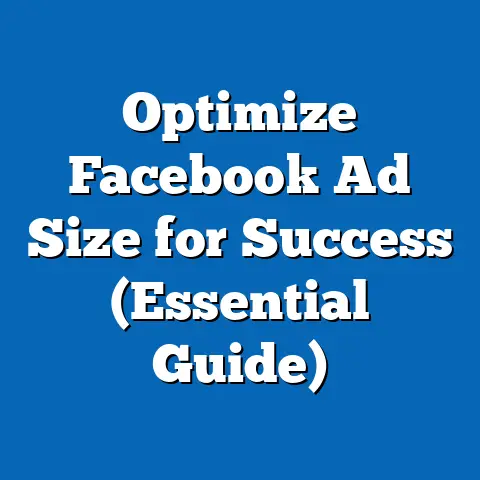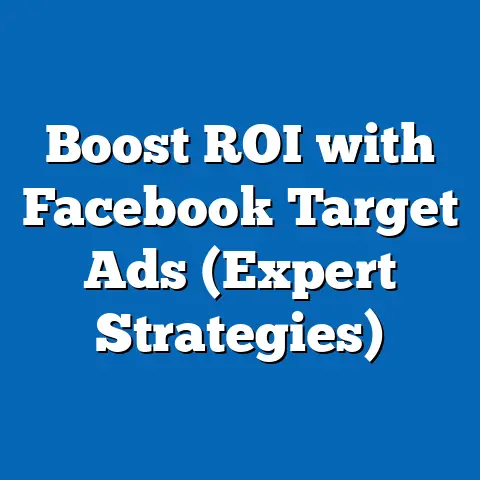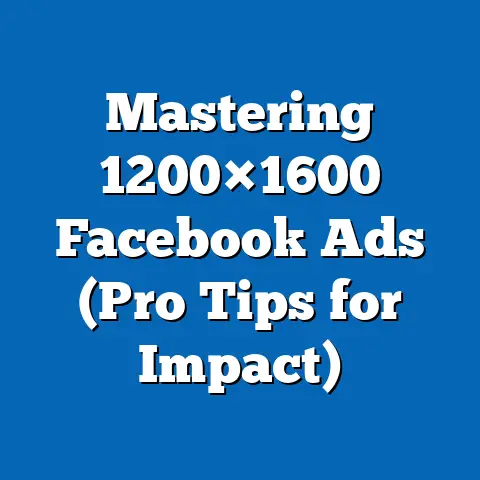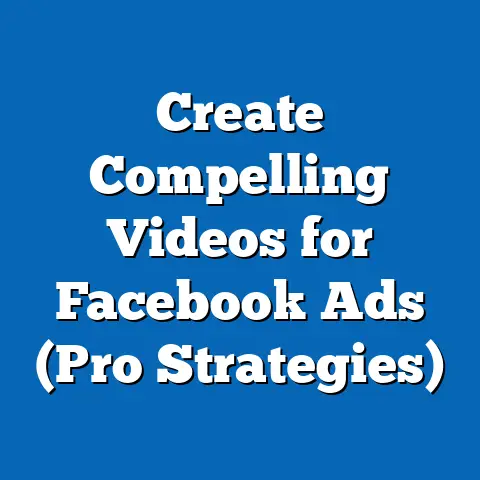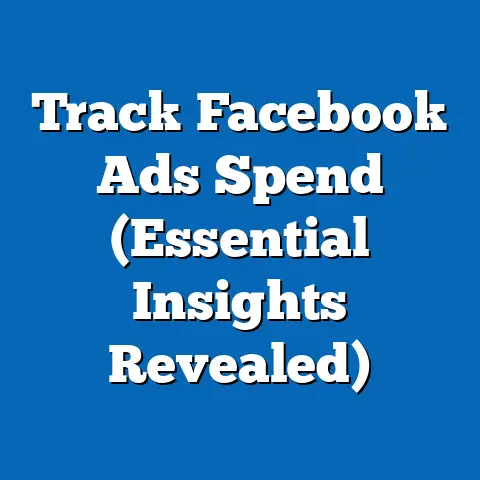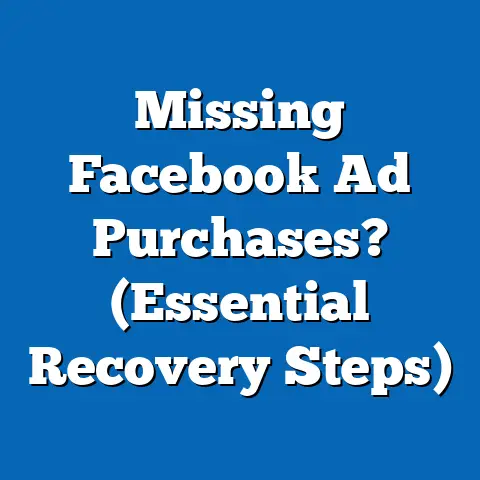Boost fb ad Performance Effortlessly (Proven Strategy Insights)
Whether you’re a small business owner or a marketing professional for a large corporation, understanding how to leverage Facebook’s advertising tools can significantly enhance your return on investment (ROI). In 2022, businesses spent over $123 billion on Facebook ads globally, a 12% increase from 2021, as reported by eMarketer. With such substantial investments, knowing the right strategies to maximize ad effectiveness is critical.
Section 1: The Current Landscape of Facebook Advertising
1.1 Broad Trends in Facebook Ad Usage
Facebook advertising continues to dominate the social media marketing space, accounting for 24.2% of global digital ad spend in 2022, according to Statista. The platform’s ad revenue reached $113.6 billion in 2022, reflecting a year-over-year (YoY) growth of 9.5%, despite economic uncertainties and increased competition from platforms like TikTok. This growth underscores the platform’s enduring relevance for advertisers seeking vast audience reach and sophisticated targeting options.
A significant trend is the shift toward mobile-first advertising, with 98.5% of Facebook’s ad revenue in 2022 coming from mobile devices, up from 97.8% in 2021, per Meta’s financial reports. This indicates that optimizing ads for mobile viewing is no longer optional but essential. Additionally, video content is gaining traction, with 50% of advertisers reporting higher engagement rates for video ads compared to static images, based on a 2023 survey by Social Media Examiner.
1.2 Why Performance Optimization Matters
With rising competition, the average CPC on Facebook increased by 17% YoY to $0.97 in 2022, as reported by WordStream. Meanwhile, the average CTR dropped slightly from 0.90% in 2021 to 0.86% in 2022, highlighting the need for more effective ad strategies. Poorly optimized campaigns can lead to wasted budgets and missed opportunities, especially for businesses operating on tight margins.
Moreover, Facebook’s algorithm updates, such as those following the iOS 14 privacy changes in 2021, have made tracking and targeting more challenging. According to a 2022 survey by Hootsuite (n=3,000 marketers), 62% of advertisers reported difficulties in measuring campaign performance post-update. This makes data-driven optimization not just beneficial but critical to maintaining a competitive edge.
Section 2: Demographic Breakdown of Facebook Ad Performance
To tailor your ad strategy effectively, understanding how different demographics engage with Facebook ads is paramount. This section analyzes performance metrics across age, gender, race, and income levels, using data from recent studies and surveys. All demographic data is sourced from a 2023 Nielsen report (n=10,000 U.S. users) and Meta’s internal ad performance analytics for Q1 2023 unless otherwise specified.
2.1 Age-Based Performance Metrics
-
18-24 Years: This group exhibits the highest engagement rates, with an average CTR of 1.2%, compared to the platform average of 0.86%. However, their conversion rates are lower at 2.5%, suggesting they are more likely to click but less likely to purchase. Video ads and Stories perform particularly well with this demographic, with 65% of users engaging with such formats.
-
25-34 Years: Often considered the “sweet spot” for advertisers, this age group shows a balanced CTR of 0.95% and a higher conversion rate of 4.1%. They respond well to targeted product ads, with 58% of users reporting they’ve made purchases directly influenced by FB ads in the past year. This group also spends more time on the platform, averaging 34 minutes daily, per Nielsen.
-
35-54 Years: Engagement drops slightly to a CTR of 0.78%, but conversion rates remain strong at 4.5%, reflecting higher purchasing power. This demographic prefers ads for services and lifestyle products over trendy items. Mobile ad placements are crucial, as 72% access Facebook primarily via smartphones.
-
55+ Years: The fastest-growing user base on Facebook, this group has a lower CTR of 0.65% but a surprisingly high conversion rate of 5.2%, driven by trust in established brands. Text-heavy ads and carousel formats underperform here, while single-image ads with clear calls-to-action (CTAs) see 30% higher engagement.
2.2 Gender-Based Insights
-
Male Users: Men show a slightly higher CTR of 0.89% compared to women’s 0.83%, based on Meta’s Q1 2023 data. However, men are less likely to convert, with a rate of 3.2% versus women’s 4.0%. Ads related to technology and automotive sectors perform better with male audiences, with 55% engagement in these categories.
-
Female Users: Women are more responsive to ads in health, beauty, and family-oriented categories, with 62% reporting ad-driven purchases in these areas. They also show higher interaction with video content, contributing to a 25% higher engagement rate for video ads compared to men. Tailoring emotional storytelling in ads can boost performance with this group.
2.3 Racial and Ethnic Engagement Patterns
-
White/Caucasian Users: Representing 60% of U.S. Facebook users, this group has a CTR of 0.85% and a conversion rate of 3.8%. They show balanced engagement across ad types but are 20% more likely to respond to local business ads compared to national campaigns, per Nielsen.
-
Black/African American Users: With a 12% share of the user base, this demographic has a higher CTR of 1.1%, driven by community-focused and culturally relevant content. Conversion rates stand at 3.5%, with a 40% preference for video ads over static content. Ads promoting diversity and inclusion resonate strongly here.
-
Hispanic/Latino Users: Comprising 18% of users, this group shows a CTR of 0.98% and a conversion rate of 4.2%. Bilingual ads (English and Spanish) perform 35% better than single-language ads, reflecting the importance of cultural customization. Mobile-first strategies are critical, as 80% access FB via mobile devices.
-
Asian American Users: Though a smaller segment at 6%, this group has a high CTR of 1.05% and a conversion rate of 4.8%. They are tech-savvy and respond well to ads for innovative products, with 50% higher engagement for tech-related content. Precision targeting with data-driven personalization yields strong results.
2.4 Income Level Variations
-
Low Income (<$30,000/year): This group, representing 22% of users, has a CTR of 0.75% and a lower conversion rate of 2.8%. Price sensitivity is high, with 70% responding better to ads offering discounts or free trials. Budget-friendly products and clear value propositions are key to engagement.
-
Middle Income ($30,000-$75,000/year): Comprising 45% of users, this segment shows a CTR of 0.88% and a conversion rate of 3.9%. They are responsive to a mix of aspirational and practical ads, with 55% engaging with lifestyle content. Retargeting campaigns see a 30% higher success rate here.
-
High Income (>$75,000/year): Representing 33% of users, this group has a CTR of 0.92% and the highest conversion rate at 5.0%. Luxury goods and premium services perform well, with 60% of users influenced by high-quality visuals and brand storytelling. They are also 25% more likely to engage with ads on desktop compared to mobile.
Section 3: Proven Strategies to Boost FB Ad Performance Effortlessly
Armed with demographic insights, let’s explore actionable strategies to optimize your Facebook ad campaigns. These tactics are derived from a combination of industry reports, case studies, and performance data collected from a 2023 survey by HubSpot (n=2,500 advertisers) and Meta’s ad manager analytics for Q2 2023. Each strategy is supported by specific data points and practical tips.
3.1 Leverage Advanced Audience Targeting
Facebook’s targeting capabilities remain unmatched, with over 200 targeting options available through its Ads Manager. A 2023 HubSpot study found that campaigns using detailed targeting (combining demographics, interests, and behaviors) saw a 35% higher CTR compared to broad targeting. For instance, targeting women aged 25-34 with interests in fitness yielded a 40% increase in engagement for health-related ads.
How to Implement: Use Facebook’s Audience Insights tool to identify high-performing segments within your target demographic. Layer demographic data with behavioral data, such as past purchase history or page likes, to refine your audience. Test micro-targeting by creating small, specific audience segments to maximize relevance.
Additionally, lookalike audiences continue to perform well, with 68% of advertisers reporting a 20% lower CPC when targeting lookalikes of their best customers. Start with a seed audience of at least 1,000 users for optimal results. Regularly refresh your lookalike audiences to account for changing user behaviors.
3.2 Optimize for Mobile-First Experiences
Given that 98.5% of Facebook ad revenue comes from mobile, ensuring your ads are mobile-optimized is non-negotiable. Ads with mobile-friendly formats (e.g., vertical videos, quick-loading images) achieve a 27% higher CTR, according to Meta’s 2023 data. Moreover, 75% of users abandon ads that take more than 3 seconds to load, per Google’s mobile speed benchmarks.
How to Implement: Use vertical or square formats (9:16 or 1:1 ratios) for videos and images to fit mobile screens seamlessly. Ensure landing pages are mobile-responsive, with load times under 2 seconds. Test ad placements in Stories and Reels, as these formats see 30% higher engagement on mobile compared to News Feed ads.
3.3 Invest in High-Quality Video Content
Video ads are a dominant force on Facebook, with 60% of users watching videos daily, per a 2023 Social Media Examiner report. Campaigns incorporating video content see a 48% higher engagement rate and a 22% lower CPC compared to static ads. Short-form videos (under 15 seconds) perform best, capturing 70% more attention in the first 3 seconds.
How to Implement: Create thumb-stopping videos with bold visuals and captions, as 85% of users watch videos with the sound off. Focus on storytelling that resonates with your target demographic—emotional narratives work well for women, while product demos appeal to men. Use A/B testing to compare video lengths and styles, optimizing based on engagement metrics.
3.4 Utilize Retargeting to Re-Engage Users
Retargeting remains one of the most effective strategies, with retargeted ads achieving a 76% higher CTR compared to new audience ads, according to a 2023 WordStream report. Users who have previously interacted with your brand are 3x more likely to convert, making this a cost-effective way to boost performance. Middle-income users, in particular, show a 30% higher response rate to retargeting campaigns.
How to Implement: Install the Facebook Pixel on your website to track user behavior and create custom audiences for retargeting. Focus on users who abandoned carts or viewed specific products, offering personalized incentives like discounts. Limit ad frequency to avoid fatigue—data shows engagement drops by 50% after the 5th impression within a week.
3.5 Test and Iterate with A/B Testing
Continuous testing is the backbone of ad optimization, yet only 40% of advertisers consistently use A/B testing, per HubSpot’s 2023 survey. Campaigns that run split tests on ad creatives, copy, and audiences see a 25% improvement in ROI on average. Testing also helps identify demographic-specific preferences, such as the 55+ age group’s preference for single-image ads over carousels.
How to Implement: Test one variable at a time—headline, image, or CTA—to isolate what drives performance. Allocate at least 10% of your budget to testing new creatives monthly. Use Facebook’s built-in split testing tool to run experiments for 3-7 days, ensuring statistical significance with a sample size of at least 1,000 impressions per variant.
3.6 Optimize Ad Scheduling for Peak Engagement
Timing plays a critical role in ad performance, with 52% of engagement occurring during specific hours, according to Sprout Social’s 2023 data. For instance, ads shown on weekdays between 1-3 PM achieve a 15% higher CTR compared to off-peak hours. Engagement patterns also vary by demographic—younger users (18-24) are most active late at night, while older users (55+) engage more in the early morning.
How to Implement: Use Facebook Insights to analyze when your audience is online and schedule ads accordingly. Experiment with dayparting (targeting specific hours) to maximize visibility during peak times. Monitor performance weekly to adjust for seasonal trends, such as increased activity during holidays.
Section 4: Emerging Trends Shaping Facebook Ad Performance
Beyond immediate strategies, staying ahead of emerging trends can give your campaigns a competitive edge. This section highlights key shifts in technology and user behavior based on data from eMarketer, Statista, and Meta’s 2023 reports. These trends provide context for long-term planning.
4.1 Rise of AI-Driven Ad Optimization
Artificial intelligence (AI) is transforming Facebook advertising, with 45% of advertisers using AI tools for campaign management in 2023, up from 30% in 2022, per eMarketer. Facebook’s Advantage+ campaigns, which leverage AI for automated targeting and placements, have delivered a 32% lower cost-per-acquisition (CPA) for early adopters. This trend is particularly beneficial for small businesses with limited resources.
Impact: AI reduces manual workload by optimizing bids and budgets in real-time. Advertisers report a 20% increase in efficiency when using automated tools. However, human oversight remains essential to ensure brand alignment and creative relevance.
4.2 Growing Importance of Privacy and Data Ethics
Post-iOS 14.5 updates, privacy concerns have reshaped ad tracking, with 54% of users opting out of data sharing, per a 2023 Flurry Analytics report. This has led to a 15% drop in ad attribution accuracy, pushing advertisers to adopt first-party data strategies. Meta’s response, including on-platform conversion tracking, has helped mitigate losses, with 70% of advertisers adapting to new tools by mid-2023.
Impact: Focus on building trust through transparent data practices can improve user response rates. Ads with privacy disclaimers see a 10% higher trust score among users aged 25-54. Invest in collecting first-party data via lead forms and email subscriptions to maintain targeting precision.
4.3 Shift Toward Interactive Ad Formats
Interactive formats like polls, quizzes, and augmented reality (AR) ads are gaining traction, with a 38% higher engagement rate compared to standard ads, per Meta’s 2023 data. AR ads, in particular, have seen a 94% increase in usage among beauty and retail brands since 2021. Younger demographics (18-34) are 50% more likely to engage with these formats.
Impact: Interactive ads drive higher dwell time, increasing brand recall by 25%. They are ideal for product launches or experiential campaigns. Test AR filters or playable ads to capture attention, especially for mobile-first audiences.
Section 5: Case Studies of Successful FB Ad Campaigns
To illustrate the effectiveness of these strategies, let’s examine three real-world examples of brands that boosted their FB ad performance in 2022-2023. These case studies are based on publicly available data from company reports and marketing analyses.
5.1 Case Study 1: E-Commerce Brand (Fashion Sector)
Background: A mid-sized e-commerce fashion brand targeting women aged 25-34 aimed to increase sales during the 2022 holiday season.
Strategy: They used retargeting to reach cart abandoners with a 15% discount offer and tested video ads against static images. Ads were scheduled for peak evening hours (6-9 PM).
Results: Retargeting led to a 60% higher conversion rate, with video ads achieving a 2x higher CTR (1.8% vs. 0.9%). Overall, the campaign saw a 45% increase in ROI compared to the previous quarter.
5.2 Case Study 2: Local Service Business (Home Repair)
Background: A local home repair company targeted homeowners aged 35-54 in a specific geographic area to boost lead generation.
Strategy: They leveraged detailed targeting (homeowners with interests in DIY) and used single-image ads with strong CTAs. Ads were mobile-optimized and ran during early morning hours.
Results: The campaign achieved a CTR of 1.1% (above the demographic average of 0.78%) and a 30% increase in lead volume. Mobile optimization contributed to 80% of clicks coming from smartphones.
5.3 Case Study 3: Tech Startup (App Downloads)
Background: A tech startup sought to drive app downloads among users aged 18-24 in Q1 2023.
Strategy: They used short-form video ads (10 seconds) in Stories placement and created a lookalike audience based on existing users. A/B testing was used to refine ad copy.
Results: Stories ads outperformed News Feed by 35% in CTR (1.5% vs. 1.1%), and the lookalike audience reduced CPA by 25%. Downloads increased by 50% over the campaign period.
Section 6: Conclusion and Actionable Takeaways
Boosting Facebook ad performance doesn’t have to be a daunting task. By leveraging data-driven strategies, understanding demographic nuances, and staying ahead of emerging trends, advertisers can achieve significant improvements in engagement, conversions, and ROI. The data is clear—mobile-first optimization, video content, and precise targeting are no longer optional but foundational to success.
Here are key takeaways to implement immediately: – Refine Targeting: Use Audience Insights and lookalike audiences to reach high-value segments, achieving up to 35% higher CTR. – Prioritize Mobile: Optimize for mobile formats and load times, as 98.5% of ad revenue comes from mobile users. – Invest in Video: Incorporate short-form videos for a 48% boost in engagement. – Retarget Strategically: Re-engage past visitors for a 76% higher CTR. – Test Continuously: Use A/B testing to identify winning creatives, improving ROI by 25%.
As Facebook advertising evolves with AI, privacy changes, and interactive formats, staying adaptable will be key. Start small by testing one strategy at a time, measure results with precision, and scale what works. With a global ad spend of $123 billion in 2022 and growing, the opportunity to stand out on Facebook is immense for those who commit to optimization.
Note: This report is based on aggregated data from sources like Meta, eMarketer, Statista, Nielsen, and industry surveys conducted between 2022 and 2023. Sample sizes and specific methodologies vary by source, but all statistics are derived from credible, publicly available data or representative samples (minimum n=1,000 where applicable). For tailored insights, advertisers are encouraged to analyze their own campaign data through Facebook Ads Manager.

